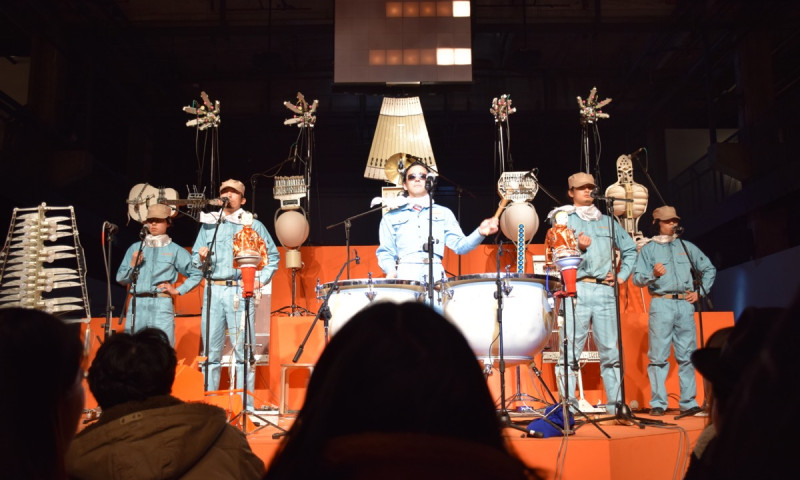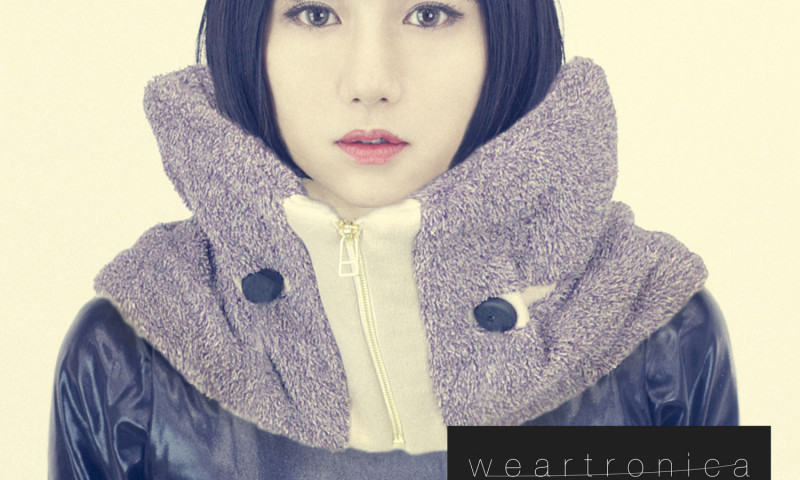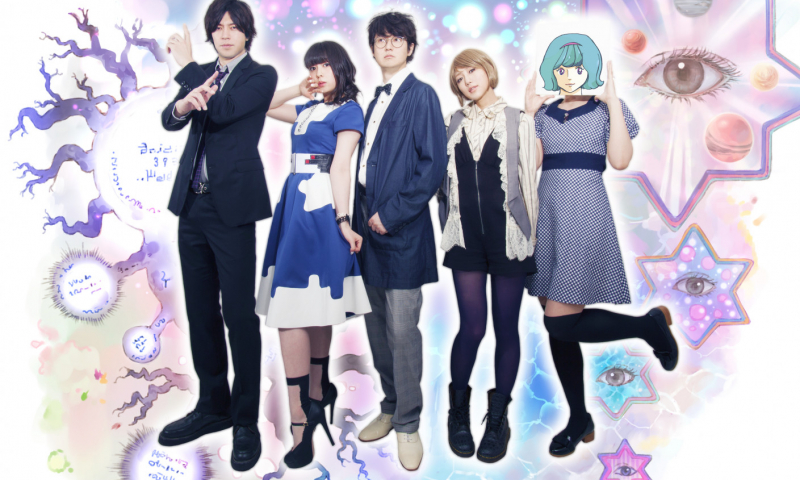
TOKYO CUTTING EDGE CREATORS by Julie Watai #11 featuring Frenesi: The Singer-Songwriting-Animator
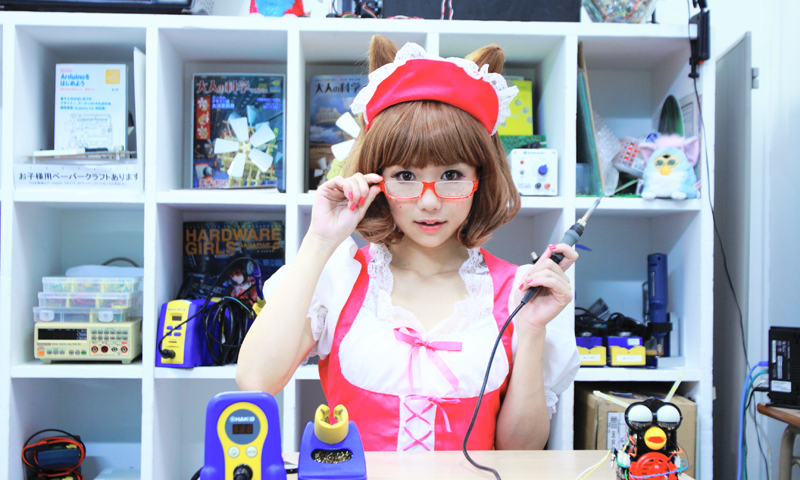
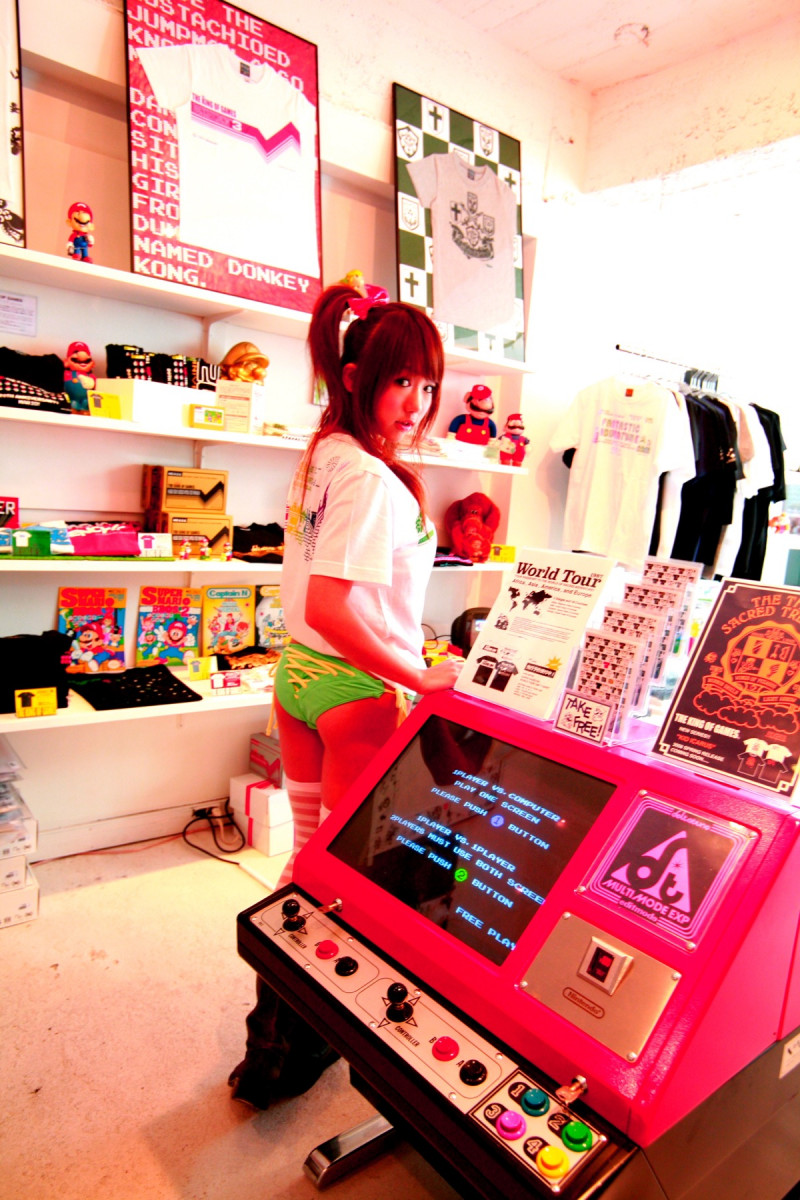
TOKYO CUTTING-EDGE CREATORS by Julie Watai is column series, which covers Tokyo’s latest cutting-edge culture! In this series she’ll be interviewing creators that have caught her interest, in order to discover the latest cutting-edge culture in Tokyo. We have interviewed Ai☆Madonna, Junya Suzuki from chloma, Etsuko Ichihara, TORIENA, and Tadashi Shimaya, Nukeme, and Keisuke Nagami from HATRA, and Novmichi Tosa from Maywa Denki, and Tomofumi Yoshida from Techno-Shugei Club.
東京の最先端カルチャーを常に追いかけ続けているJulie Wataiさんの連載『TOKYO CUTTING-EDGE CREATORS by Julie Watai』。この連載では、Julie Wataiが注目するクリエイターとの対談を通じ、新たな東京の最先端カルチャーを発見していきます。初回では愛☆まどんなさん、第2回目ではchloma鈴木淳哉さん、第3回目では市原えつこさん、第4回ではTORIENAさん、第5回では島谷直志さん、第6回ではヌケメさん、第7回ではHATRA長見佳祐さん、第8回では明和電機土佐信道さんと、第9回ではテクノ手芸部のよしだともふみさんにインタビューを行いました。
For the 10th installment, we’ll be interviewing Masaaki Enami from Representative of EDITMODE.
そして第10回目となる今回は、㈱エディットモード代表の江南匡晃さんにお話しを伺いました。
Julie: Long time, no see. I haven’t seen you since Fami-mode.(Fami-mode is a chiptune musician event held every January in Tokyo; Julie Watai has also DJed at it.) THE KING OF GAMES (EDITMODE’s apparel label) always has a booth set up there.
Julie:お久しぶりです。ファミ詣(毎年1月に東京で開催されるチップチューン系音楽イベント。JulieもDJで参加していました)以来ですね。THE KING OF GAMES は毎回出店されていますよね。
Enami: Long time, no see to you as well. I think it’s been round two or three years since we last met.
江南:お久しぶりです。お会いするのは2、3年ぶりですね。
Julie: It’s been longer than I thought, then. By the way, did you have a booth at Fami-mode 2017?
Julie:思ったより結構経ってますね。ちなみに2017年のファミ詣も出店されていましたか?
Enami: Yes, we did. But because of the change in venue, we did an afternoon event instead of an all-night one.
江南:はい。出しましたよ。でも、会場が変わったのと、デイイベントになって昼間になったんです。
Julie: I see. I can see how it’d be something enjoyable even during the day. Some of the attendees are a little older, and it seems like all night events would be more tiring physically.
Julie:そうだったんですね。確かに、オールナイトじゃなくても楽しめるだろうな思っていました。年齢の高いお客さんもいるから、オールナイトだと体力的にキツいような気がしていました。
Enami: I feel the same way. Also, there were attendees who brought their children with them.
江南:そうなんですよ。体力的に限界(笑)。他にも、子連れのお客さんもいました。
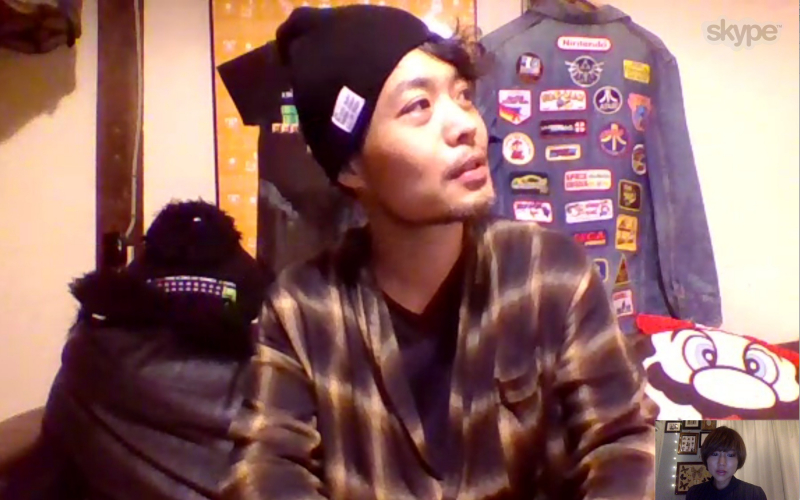
The interview was conducted via Skype. / 対談はSkypeで行われました
Julie: By having it in the afternoon, more people that fit into those categories could come. That’s great. By the way, aren’t you around the same age as me? I was born in 1979.
Julie:デイイベントになるとそういうお客さんも来るんですよね。いいですね。
そういえば、江南さんは多分私と同世代ですよね。私は1979年生まれです。
Enami: I was born in 1974. I’m 43 years old.
江南:僕は1974年生まれの43歳です。
Julie: Oh, then you’re a little older than me. But that still puts us around the same age. Were you part of the generation whose first console was the Nintendo Famicon (NES)?
Julie:私よりも少し年上でしたか、失礼しました。でも、世代は同じくらいですね。ファーストゲーム機はファミコンの世代ですかね。
Enami: I had a GAME&WATCH in first grade, and then got a Famicon in the third grade.
江南:ゲーム&ウォッチが小1で、ファミコンが小3です。
Julie: A GAME&WATCH? Man, that takes me back! It came out before the Famicon did. Do you remember what the first GAME&WATCH title you played was called?
Julie:ゲーム&ウォッチ!懐かしい~。ファミコン以前のゲーム機ですね。初めて遊んだゲーム&ウォッチのタイトル、覚えていますか?
Enami: Actually, the solar-powered game machine sold by Bandai Electronics called Escape from the Devil’s Doom, and after that it was Donkey Kong. I still have them.
江南:バンダイエレクトロニクスの天国と地獄というソーラーパワーで動くのが一番最初で、その次にドンキーコングです。当時のものを今も持ってます。
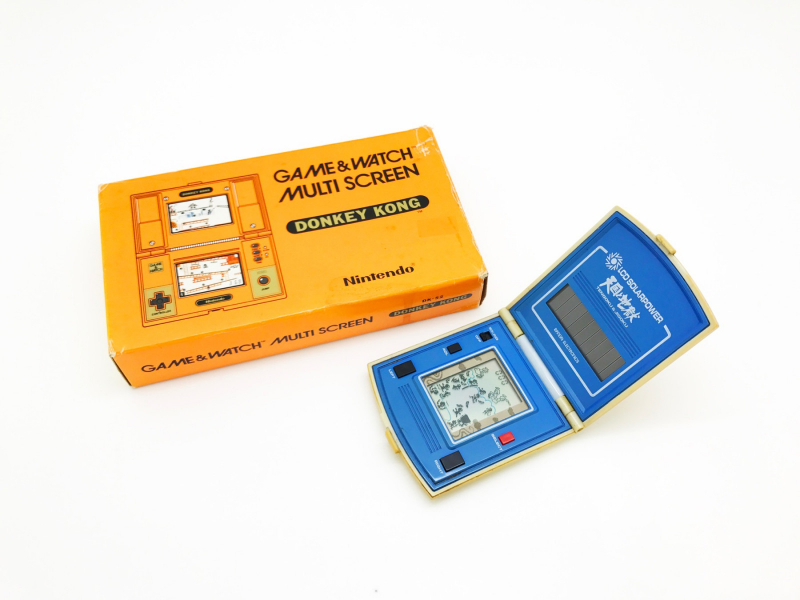
Left:Donkey Kong, Right:Escape from the Devil’s Doom
Julie: They did have solar-powered game machines back then, didn’t they. Come to think of it, it doesn’t seem so strange when you think of how popular solar-powered calculators were back then. Donkey Kong was a really popular title. Nowadays, copies of it that still work fetch a pretty high price at retro game shops. I used to collect junk Game & Watch machines. I thought they made for cool pieces of interior decor.
Julie:そんな昔からソーラーパワーのゲーム機ってあったんですね。でも、よく考えたらソーラー電卓が流行っていたし、納得できます。ドンキーコングは名作ですよね。今、完動品はレトロゲームショップで価値が結構上がってますよね。昔、ジャンク品のゲーム&ウォッチをちょこちょこ集めてました。インテリアとしてもかっこいいですよね。
Emani: You’re right. Not to mention that because the life of the machine depended on its LCD display, eventually they would stop working.
江南:確かに。しかも、あの辺のゲームは液晶に寿命があるからそのうち消える運命ですね。
Julie: They had a really short life.
Julie:儚い命ですね・・・。
Enami: The Nintendo GAME&WATCH was best when it came to quality, and it had great sound.
江南:任天堂のゲーム&ウォッチが一番作りも良くて音も良かったですね。
Julie: It had such a sleek design that adults didn’t look out of place carrying one, either.
Julie:デザインも大人も持てそうなくらいかっこいいですよね。
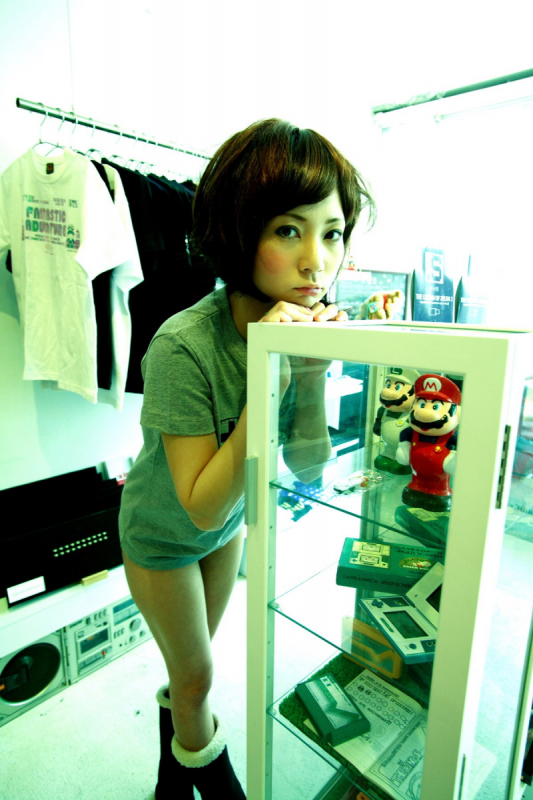
Photo:Julie Watai, Model:Maki, Location:deltatune/撮影:Julie Watai、モデル:Maki、撮影協力:deltatune
Emani: Even the first commercial for it didn’t make it seem like it was something they were necessarily marketing toward children.
江南:確かCMも子供向けじゃなかったんじゃないかな?最初は。
Julie: I had no idea. I feel like the crystal screen GAME&WATCH was really at the top of its class.
Julie:そうだったんですね。それは初めて知りました。クリスタルスクリーンのゲーム&ウォッチとか高級感がすごいですよね。
Julie: Tell me what your top three games were when you were in elementary school.
Julie:江南さんが小学生の頃、好きだったゲームソフトを3つ教えてください。
Enami: Oh! That’s a hard question.
江南::おお!迷うなぁ。
Julie: You probably had a lot, but if you can, try and narrow it down.
Julie:多分いっぱいあると思いますが(笑)。厳選してお願いします。
Enami: Okay, then Super Mario Bros., Dragon Quest III, and Megami Tensei. Dragon Quest III was in junior high school, though.
江南:スーパーマリオ、ドラクエ3、女神転生かな。ドラクエ3は中学生の頃ですが(笑)
Julie: Oh! All of three are classics. Ah, I see, Dragon Quest III came out when you were in junior high school.
Julie:名作3本ですね。ドラクエ3は中学生の頃なんですね。
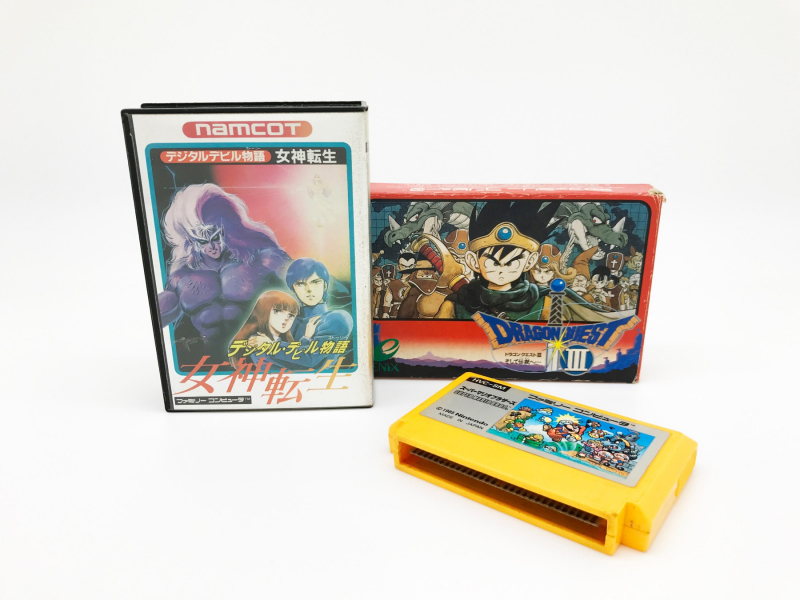
Left:Megami Tensei, Center:Dragon Quest Ⅲ, Super Mario Bros.
Emani: Dragon Quest I and Dragon Quest II came out when I was in the upper grades of elementary school.
江南:ドラクエ1と2が小学校高学年でした。
Julie: I played Dragon Quest I right after Dragon Quest III, unable to contain my excitement for its next installment. That was in elementary school. Megami Tensei struck me as being “for adults” at the time. It had a kind of sinister feel to it.
Julie:ドラクエ1は3の後に次作を待ちきれなくてプレイしました。小学生の頃でしたね。女神転生は大人のゲームの印象がありました。ちょっと雰囲気も怖くて。
Emani: At the time, Megami Tensei it was kind of like an offshoot from a mix of media, since they came out with an anime, novel, and game for it. I got into the anime version of it through the anime show Anime Daisuki! that was broadcast during summer vacations, and then I bought and played the game version.
江南:女神転生は当時、メディアミックスの走りみたいな感じで、アニメ、小説、ゲームと展開していました。夏休みに放送されていた「アニメだいすき!」というテレビ番組をきっかけにアニメ版にハマって、ゲームも買って遊んでいました。
Julie: I also used to watch Anime Daisuki!, too. They used to broadcast OVA anime and the like. There was something unique about the Megami Tensei anime.
Julie:私も「アニメだいすき!」観ていました。OVAのアニメ等を放送していましたよね。女神転生はアニメ版も独特の雰囲気がありました。
Enami: I really loved Anime Daisuki! and I would always record it on tape.
江南:「アニメだいすき!」は大好きで、いつもビデオに録画していました。
Julie: Not to change the subject, but which part of the Super Mario series did you play through the most?
Julie:ちなみに、スーパーマリオはどのシリーズを一番やりこみましたか?
Enami: Definitely the first. I had it memorized so well that I would doodle world maps of it in my notebook during class. At the time I thought, “If only it had an edit mode…” and that became the inspiration behind the label’s name (EDITMODE). I wish I could have told my younger self that someday they would come out with Super Mario Maker like they have now.
江南:マリオはやはり初代で、授業中にノートにマップ描けるくらい憶えていました。このゲームにエディットモード機能があったらなぁという思いが、そのまま会社名(THE KING OF GAMES は江南さんが代表を務める、株式会社エディットモードのブランド)になりました。今はマリオメーカーが出たから、あの当時の僕に教えてあげたいですね。
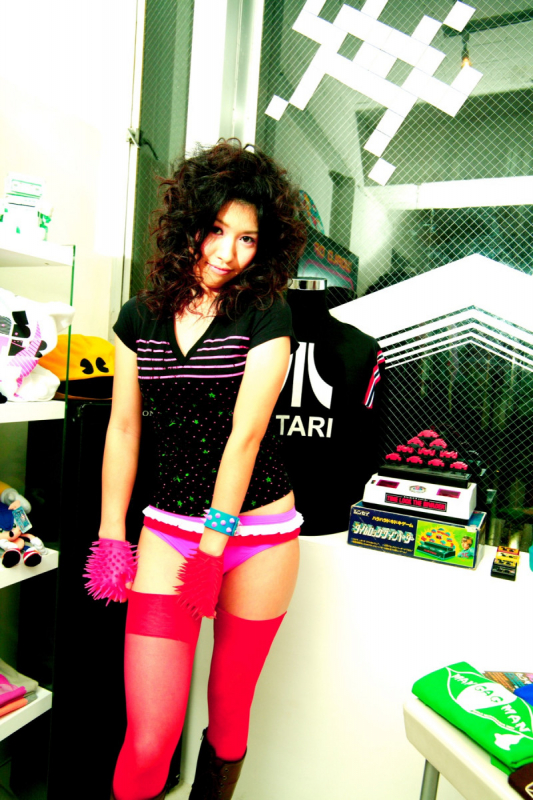
Photo:Julie Watai, Model:Natsumi Goto, Location:deltatune/撮影:Julie Watai、モデル:後藤夏実、撮影協力:deltatune
Julie: So that’s the backstory behind the company name. I played through the first Super Mario a lot myself. I’ve often wondered what exactly made it so playable time after time. Recently I’ve been replaying it on the Nintendo Classic Mini Family Computer, and even now I remember the world maps in it.
Julie:社名にそんな経緯があったんですね!私も初代やりこみました。なんであんなに繰り返し出来たんだろうと思うくらい。最近、ファミコンミニでたまにやってますけどマップ憶えてますよね(笑)
Emani: I guess that’s what happens when you develop muscle memory. But now I can’t play it as well as I used to. (laughs) I’ve gotten older…
江南:体が憶えてる、とはまさにこの事ですよね。でも、あの当時のようなプレイが今は出来ない(笑)。老いが・・・。
Julie: There were a lot of unforgiving rules for reflexes, or if one pixel was off it’d immediately be game over, etc.
Julie:反射神経とか、あのシビアな1ドットミスで即ゲームオーバーとかのルールとか・・・。昔は当たり前だったんですけどね。
Julie: You talked about where the name for your company came from, but tell me a little more about the backstory behind launching KING OF GAMES.
Julie:社名の由来のお話しがありましたが、THE KING OF GAMES を立ち上げた経緯を教えてください。
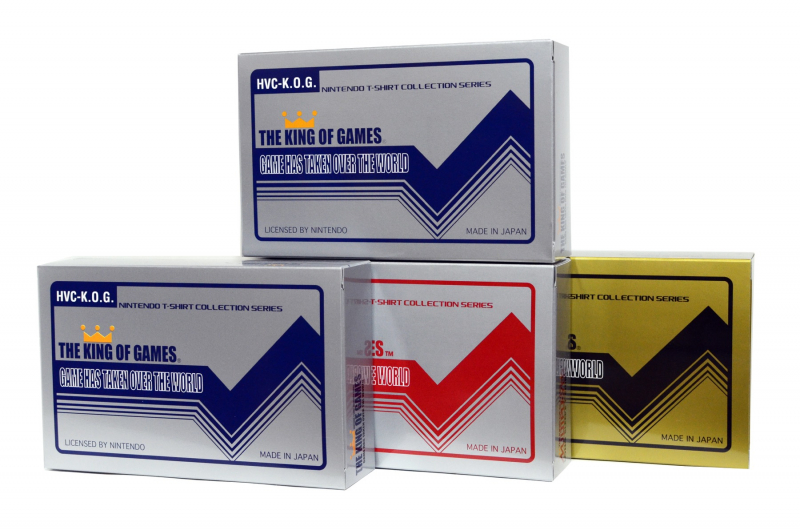
Enami: It would take too much time to go into detail, but originally I worked in the clothing industry. I also worked as a retail staffmember at a well-established select boutique in Kyoto, both buying and coming up with original items. One day I was working retail at the shop and was holding a customer’s jacket while he tried on a coat. He was wearing a shirt with a Nintendo logo on it…
江南:話が長くなりますが、元々僕はアパレル業界で働いていました。京都の老舗のセレクトショップで販売スタッフをやりながら、バイイングやオリジナル商品の開発をしていました。
ある日、店頭で接客をしていて、上着を試着するお客さんのジャケットを預かりました。すると、そのお客さんが着ていたのが、Nintendoのロゴマークの入ったTシャツだったんです。
Julie: Oh?!
Julie:おお?!
Enami: I told him excitedly that I’d like one for myself, and I learned that he worked for Nintendo, and that his t-shirt was a staff worker shirt from an exhibition called Nintendo Space World.
江南:それで、ひとり興奮してコレほしい!とかしゃべっていたら、その人は任天堂の社員で、「任天堂スペースワールド」という展示会のスタッフTシャツだったんです。
Julie: That makes sense seeing as Kyoto is Nintendo’s turf. It’s not hard to believe something like that would happen around that area.
Julie:さすが、京都は任天堂のお膝元。エリア的にそんな事が起こるんですね。
Enami: He told me that he would bring me a shirt if there were any left over at the next event, which I was really looking forward to, but what I ended up receiving from him was an American-sized, geeky looking polo shirt with “Gameboy” embroidered on it.
江南:次回余ってたらあげるよと言われて楽しみにしていましたが、もらったのはアメリカンサイズで、「ゲームボーイ」と大きく刺繍の入ったダサダサのポロシャツでした。
Julie: That was back when they only made staff member t-shirts.
Julie:スタッフTシャツしか無い時代だったんですね。
Enami: Because of this, I thought about making some myself and I gave him my business card, and asked if I could make a Nintendo logo shirt with an original store design. When I did, he told me that he thought it was an “interesting concept”, and I eagerly got to work, creating different colored versions every night on a computer my friend had at his house, which I sent to him along with a letter I wrote about how much I loved Nintendo. But then I didn’t hear anything back from him for weeks, so I called him up.
江南:こうなったら自分で作ろうと思い、その人に名刺を渡して、お店のオリジナル企画として任天堂のロゴTシャツを作れないか聞いてみました。すると、おもしろそうですね!と言われたので、舞い上がってしまって。夜な夜な友達の家のパソコンでたくさんの色バージョンを作って、自分がどれだけ任天堂のことが好きかを書いた手紙と一緒に、その人宛に送りました。でも、何週間経っても連絡が来ないので、どうなってますか?と電話で問い合わせました。
Enami: When I did, he told me as the director of the Mario Kart series, that he was only in charge oof making games and that he’d introduce you to another division that would hear me out, and then the next day I went to give my first presentation pitch to Nintendo. This was back when they had the Nintendo64.
江南:すると、その人はマリオカートシリーズのディレクターの方で、「僕はゲームを作ることが専門なので、話しを聞いてくれる部署を紹介するよ」と言われて、後日、初めて任天堂へプレゼンに行きました。Nintendo64の時代でした。
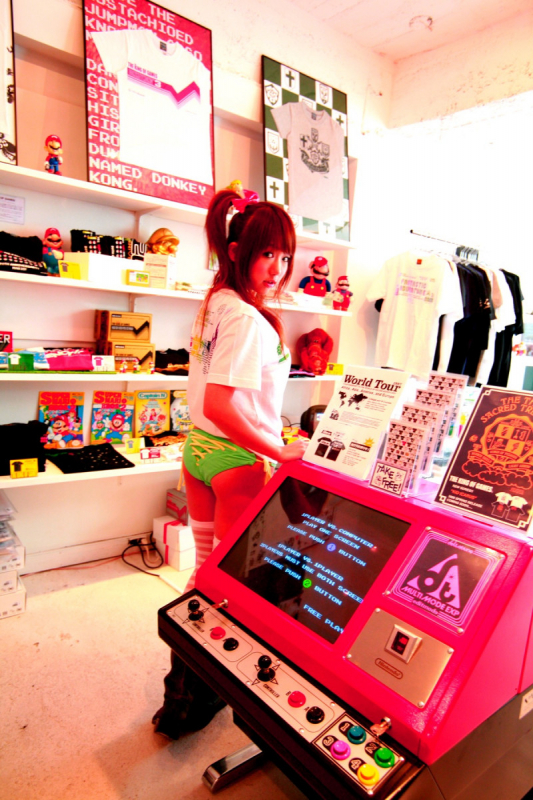
Photo, Model:Julie Watai, Location:deltatune/撮影、モデル:Julie Watai、撮影協力:deltatune
Julie: So this happened more than 15 years before THE KING OF GAMES was first launched.
Julie:THE KING OF GAMES 創業の15年以上前の話ですよね。
Enami: Yes. I was around 26 at the time.
江南:そうです。僕がたしか26歳くらいのときです。
Julie: You were really passionate!
Julie:とても熱いお話しですね!
Enami: I gave the presentation, but my hopes were completely sunk.
江南:プレゼンに行きましたが、見事に撃沈しました(笑)
Julie: Why was that?
Julie:なぜですか?
Enami: Well first of all, the Nintendo logo mark could only be used by Nintendo. Even though they were being made overseas.
江南:まず、任天堂のロゴは任天堂しか使えない。海外では作っているのですが。
Julie: There were a lot of regulations like that.
Julie:そんな規則があったんですね。
Enami: Then right after they came back to me with something and asked, “Well how about a t-shirt for this game?” which was for the Animal Crossing game they were about to release.
江南:その時、「このゲームのTシャツはどうですか?」と渡されたのが、次に発売されるNintendo64版のどうぶつの森でした。
Julie: So they suddenly they wanted to talk about t-shirt design proposal a for a new game?
Julie:いきなり新作ゲームのTシャツの企画の話がきたのですね。
Enami: What they gave me was a pamphlet for the first Animal Crossing game, which prompted me to asked them about doing a Super Mario t-shirt, but they informed me that I would only be able to use original Super Mario packaging, design, and character illustrations.
江南:初代どうぶつの森のパンフレットを渡されたので、スーパーマリオのTシャツは作れませんかと聞くと、初代スーパーマリオのパッケージのデザインやキャラクターのイラストしか使えないと言われました。
Julie: At the time, they were often marketing toward children.
Julie:時代的に、任天堂はターゲットを子供向けに絞っている風潮がありましたね。
Emani: It was common for the officially licensed Nintendo merchandise at the time to just have an illustration slapped on it. That’s why the same Super Mario images were featured on so many different stationery items.
江南: 当時の任天堂のライセンス商品は用意されたイラストをそのまま貼り付ける商品が主流で。スーパーマリオのイラストの下敷き等の文房具とかどれも同じデザインなのはそのためです。
Julie: I had no idea.
Julie:そうでしたね。
Emani: Seeing that I was in trouble, one person that had attended the meeting in casual clothes piped up by saying,“But that’s not what you want to do, right?” Back then I would write my ideas down on a notepad that I always kept in my pocket, and in my notepad I had drawn a Super Mario t-shirt design. When I showed it to them, they gave me a chance by asking me to get some ideas together and to come back to them again.
江南:僕が困っていると、一人だけ私服で会議に参加していた人が、「それは君のやりたいことと違うんでしょ」と言ってくれました。
当時僕は、アイデアをメモしたノートをいつもポケットに入れていて、その中にスーパーマリオのTシャツのラフデザインを描いていました。それを見せたら、「アイデアを整理して、もう一度見せてほしい」とチャンスをもらえました。
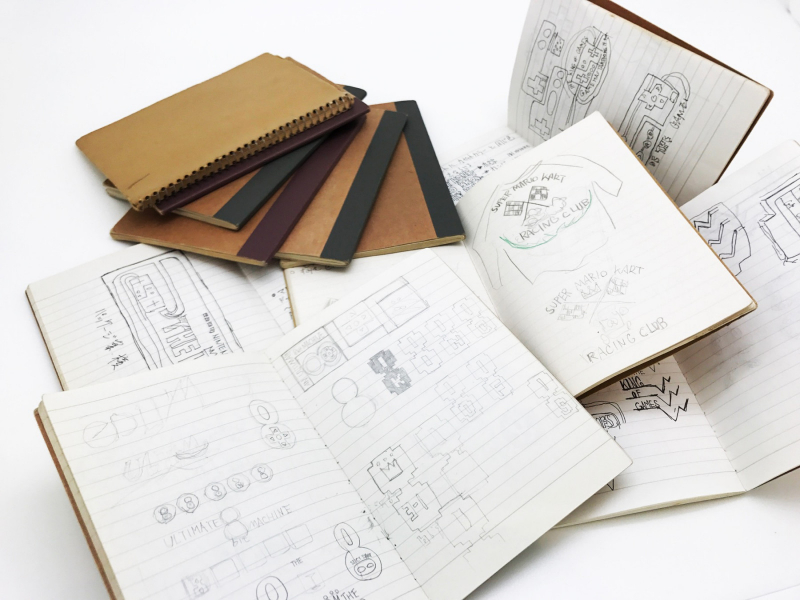
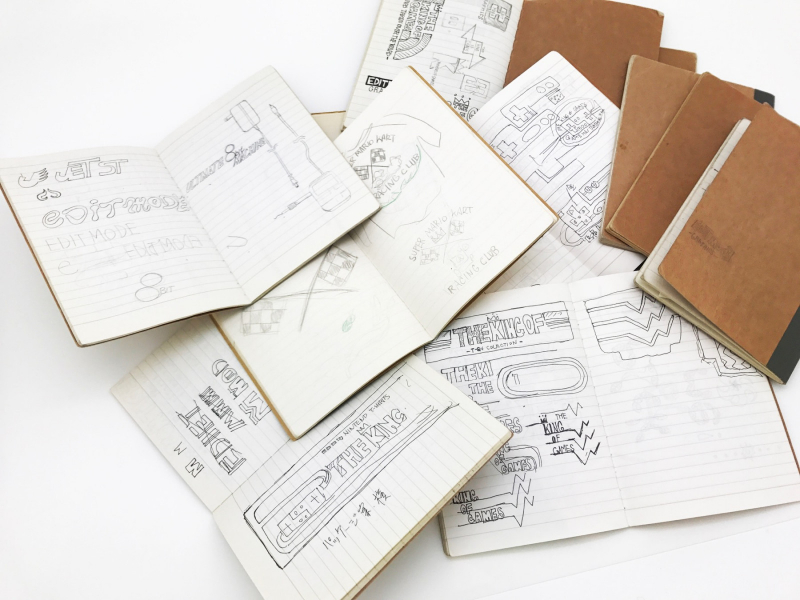
Julie: Just who was that person? (laughs)
Julie:その人は何者なんでしょうか(笑)
Enami: They even gave me the hint that,“Soon the first Mario that appeared in Donkey Kong will turn 20”.
江南:「もうすぐドンキーコングにマリオが登場して20周年だよ」というヒントも教えてもらいました。
Julie: In timing with its release.
Julie:リリースのタイミングですね。
Enami: The person who came dressed in casual clothes was from the advertising firm Hakuhodo, later transfering jobs to work at Nintendo, where he worked on the commercials for Famicon Wars and The Legend of Zelda.
江南:その私服の人は、博報堂出身で、後に任天堂に転職してファミコンウォーズ、ゼルダの伝説等のCMを手掛けた人だということが後でわかりました。
Julie: The commerical for Famicon Wars really made quite an impression. Because it used real photography, you wouldn’t have thought it was a Famicon ad. I can still sing the song from the commercial. It seems like that person understood your position about wanting to do something different.
Julie:ファミコンウォーズのCMはとても印象的でしたね。実写で、ファミコンのCMとは思えませんでした。今でもあのCMソング歌えますね。たしかに、そういう人なら、当時新しい事をやろうとしていた江南さんへの理解がありそうですね。
Enami: In light of the opportunity they had given me, I started to work from my friend’s house every night, and began rethinking everything from scratch about whether to sell it in boxes, online, etc. The hint I got about Mario’s 20th anniversary would become THE KING OF GAMES’ first pipe Mario t-shirt, which was difficult to accomplish.
The first hurdle was “no pixelated Mario”.
江南:もう一度チャンスをもらった僕は、再び、夜な夜な友達の家に入り浸って、箱に入れて販売するとか、インターネット通販をするとか、商品の骨格のようなところからすべてみなおしていく作業をはじめました。
ヒントをもらったマリオ20周年記念が THE KING OF GAMES の第一弾のドカンマリオTシャツになるのですが、これがとても大変でした。
まず、“ドット絵はマリオじゃない” からはじまります。
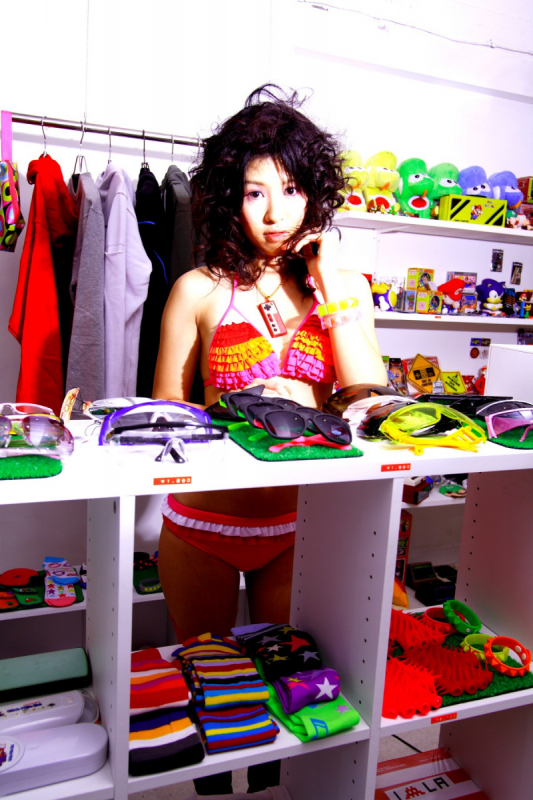
Julie: They wouldn’t let you use a pixelated Mario?
Julie:ドット絵はだめなんですか?
Enami: I was told that Mario, or at least the Mario I was shown at the meeting, had a sign that couldn’t be expressed in pixels.
江南:マリオは、会議のときに見せてもらった2Dのイラストがマリオであって、ドットのマリオは表現できなかったから記号なんだと言われました。
Julie: So that’s what they meant. They were being stubborn about it.
Julie:そんな考えだったとは。頑なですね。
Enami: But I emphasized that the Mario that people like me had grown up with was the pixelated Mario that had appeared on their TV screen.In order to convince them, I had to get approval from every department at Nintendo, and then each time someone took an issue with it, I would have to edit it, and days and days went on like that. At this rate I wasn’t really getting anywhere, and it took two years before I was able to turn it into a product.
江南:でも、僕たちはこのテレビに映ってるドットのマリオで育ったから、これもマリオなんだと力説しました。それを認めてもらうために、任天堂の全部署をまわって承認をもらい、何かNGが出たらまた修正する、という日々でした。そんな調子なので、なかなか前進せず、商品化まで2年かかりました。
Julie: I guess you could say that they represent a unified front, but… It seems like it took a long time to become officially licensed.
Julie:会社としての考えが徹底して統一されているとも言えますが・・・。任天堂の公式ブランドに至るまでにかなりの時間がかかったんですね。
Enami: During those two years, I had come up with various other designs. I bought my own computer, and I learned to master Illustrator and the like. Though the release of the pipe Mario shirt was in 2002, Mario’s actual 20th anniversary was in 2001. So the 20th anniversary t-shirt came a year late. (laugh)
江南:その2年の間に、いろいろと他のデザインもためていました。パソコンを買って、Illustratorなどを習得しました。
ドカンマリオTシャツの発売は2002年ですが、マリオ20周年は2001年。結局、1年越えてからの20周年Tシャツの発売になりました(笑)
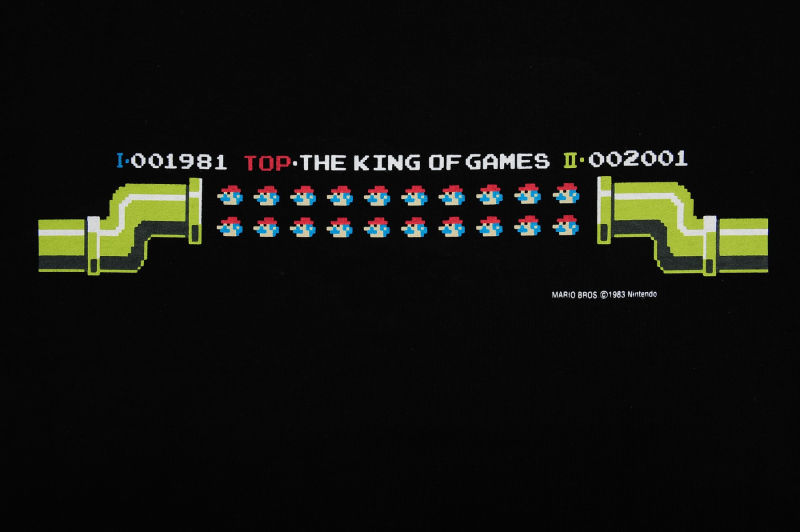
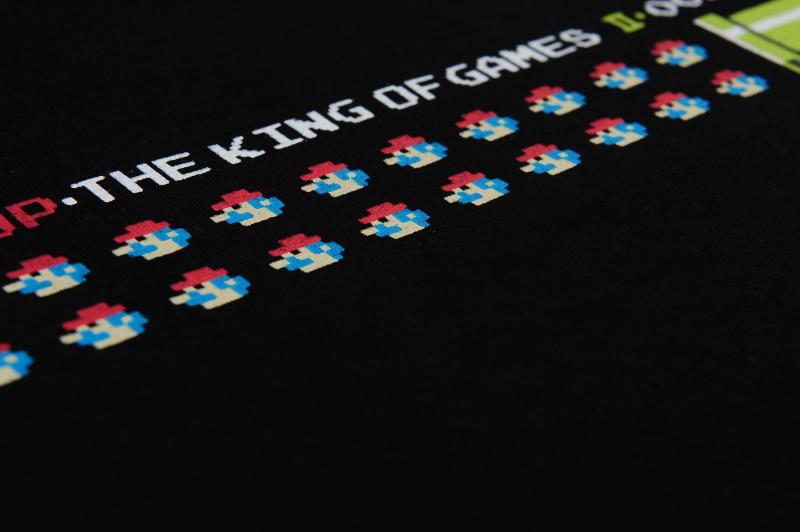
Julie: It was a really good design, though.
Julie:良いデザインですよね、本当に。
Enami: Thank you! Before we started selling it online, we only offered it for sale at the Kyoto shop I was working at, and all of the shop’s staff worked really hard to push sales of it, which I was really appreciative of. Because of my background in the apparel industry, first and foremost I wanted to create a game t-shirt that a clothing shop would seriously produce. My perspective hasn’t changed since then.
I apologize that it was a long-winded story after all. (laughs)
江南:ありがとうございます!ネット通販をはじめる前は、京都の務めていたショップのみでの販売でしたが、当時のスタッフ達が全力で売ってくれて、とても感謝しています。僕がアパレル業界出身ということもあり、まずは、服屋が本気でつくるゲームTシャツを作ろうとしていました。その考えは今も変わりません。
話が長くなりましたね(笑)
Julie: Coming up with a fitting design and straight up graphic design are two separate things, aren’t they. There’s a lot of design apparel spanning different fields of interest, but sometimes items that just have a large print on the front are difficult to wear. But the clothing that THE KING OF GAMES makes looks cool to people who aren’t familiar with its origin, and the designs are really good.
Julie:着た時にしっくりくるデザインって、単なるグラフィックデザインとは違いますよね。今でこそ、いろいろな趣味分野のデザインアパレルがありますが、前面に絵が大きくプリントされただけのものだと着づらいときもあります。THE KING OF GAMES の服は、元ネタを知らない人が見てもかっこいいと思えますし、いい服をきてるなと分かるデザインの良さがいいんだろうなと思います。
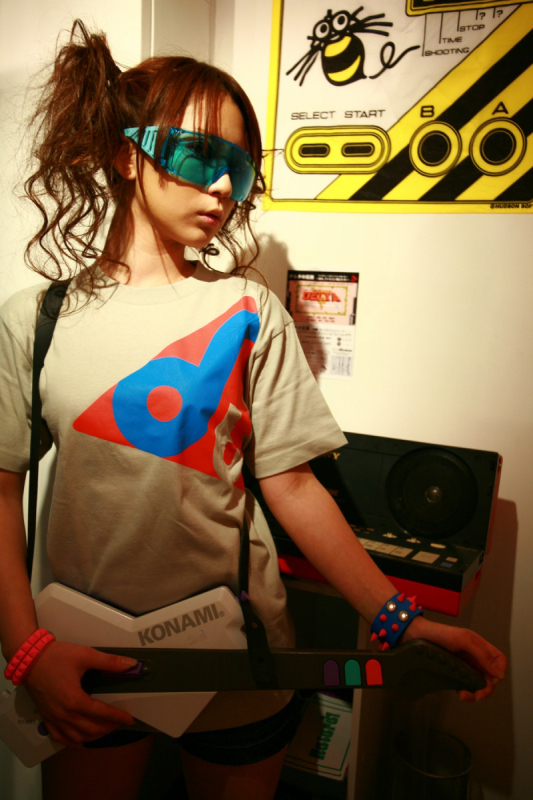
Photo:Julie Watai, Model:Maki, Location:deltatune/撮影:Julie Watai、モデル:Maki、撮影協力:deltatune
Enami: I appreciate you saying that! Sometimes trends come into play so I can’t really speak in regards to that, but originally I just wanted to design the kinds of t-shirts that I wanted to wear, which became the reason behind starting my own brand, since I wouldn’t make anything I wouldn’t wear myself. I guess you could say I’m the kind of person that prefers designs where you go like, “Oh, it’s Mario!” when you get up close to them, and so I have a habit of making designs like that.
江南:ありがとうございます!その時々の流行があるので何とも言えませんが、元々は自分が欲しいものをTシャツにしたい、という思いで始めたブランドなので、自分が着ないものは作れないなと思っています。僕はどちらかというと、よく見たら、それマリオやん!みたいなデザインが好きなので、そういうデザインになりがちです。
Julie: One-point embroidery designs or casual designs are nice, too. Speaking of THE KING OF GAMES, I think the character of one of your staff members, Chicano, is really cute and unique. Could you tell me how you two first met?
Julie:刺繍のワンポイントとか、さりげない感じもいいですよね。THE KING OF GAMES といえば、スタッフのチカーノさんのキャラも、とってもキュートで立っていますよね。出会いのきっかけを教えてください。
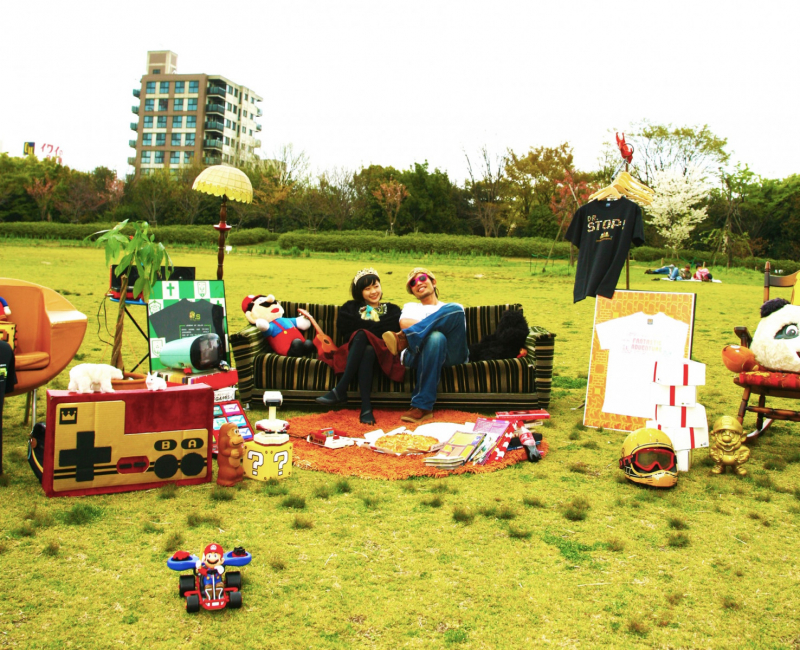
Enami: Chicano was originally a student of Director Hashimoto from Sarugakucho (a tuning company for video games located in Tokyo), which he was teaching a gaming course at Seika University in Kyoto, and she was the first to graduate from the course.
江南:チカーノは元々、猿楽庁(東京にある、テレビゲームのチューニング会社)の橋本長官が、京都の精華大学でゲームの授業をしていた時の教え子で、その授業の卒業生第一期生でした。
Julie: Seika University is Kyoto’s College of Art, isn’t it?
Julie:精華大学と言えば、京都の美大ですね。
Enami: That’s right. When she was still a student, she had brought an original work of hers with her to the Salon du Saragaku event hosted by Mr. Hashimoto in Shibuya. I used to sell merchandise at each one and met his acquiantance that way. Around the same time one of my staff members had left the company, and Mr. Hashimoto introduced me to Chicano. She a new graduate recruit.
Julie: Mr. Hashimoto has worked on a lot of really interesting projects. I also participated in his Salon du Saragaku numerous times and DJed there. So you recruited her as a new graduate.
江南:そうです。彼女は、学生の頃、長官が渋谷で開催したイベント「サロン・ド・サルガク」に自分の作品を持ってきていました。僕も毎回イベントで物販をしていたので面識がありました。会社のスタッフが独立して僕一人だけになるタイミングで、長官が紹介してくれたのがチカーノです。いわゆる新卒というやつです。
Julie: Mr. Hashimoto has worked on a lot of really interesting projects. I also participated in his Salon du Saragaku numerous times and DJed there. So you recruited her as a new graduate.
Julie:橋本長官は、いろいろと面白い企画を手掛けている方ですよね。「サロン・ド・サルガク」は、私も何度か遊びに行ったり、DJさせてもらいました。チカーノさんは新卒採用だったんですね。
Julie: In July 2017 you put on THE KING OF GAMES World Exhibition in Nakano. It was talked a lot about on SNS and on online newsites, but what kind of event was it?
Julie:2017年7月に中野で「ザ キングオブゲームズの世界展」というイベントを開催されていましたね。
SNSやネットニュースなどで話題になっていましたが、どのようなイベントだったのですか?
Enami: It was an event to commemorate THE KING OF GAMES’ 15th anniversary, and was held inside select shop METEOR’s basement gallery, the first shop I ever handled a wholesale order for.
METEOR was originally located in Kichijoji, but it moved to Nakano and where it had enough basement gallery space, and so we held it there.
江南:THE KING OF GAMES 15周年を記念して企画したイベントで、一番最初に卸として取り扱っていただいたセレクトショップ METEORさんの地下のギャラリーで開催しました。
METEORさんは元々吉祥寺にありましたが、中野に移転し、地下にギャラリースペースがあるので、そこでやらせていただきました。
Julie: Even when METEOR was still in Kichijoji, it was well-known for being a stylish, 8-bit select shop! What kind of content did you exhibit?
Julie:METEORは吉祥寺にあった頃から、オシャレな8bit系セレクトショップとして有名ですよね!
どのような展示内容だったのでしょうか。
Enami: I exhibited one piece for each year, to represent each of our 15 years, and so there were 15 pieces on display in total to show the world of games and toys that THE KING OF GAMES was founded on. The exhibit’s main feature consisted of 108 gold Mario statues, which I called “Mario Greed”. (laughs) It also put my spending habits on display for everyone to see, too. (laughs) And later I did I appeared on a talk show with Bose from Scha Dara Parr, to discuss my spending habits.
江南:15年間のそれぞれの年を代表する1型、全15着の展示と、THE KING OF GAMES の根幹であるゲームやおもちゃの世界観を表現しました。展示の目玉は、金のマリオ像を108体展示した「マリオ煩悩」です(笑) 僕の収集癖を公開した展示でもあります(笑) そして、その収集癖について、スチャダラパーのBoseさんとトークショウでしゃべりました。
Julie: Those gold Mario figures are given out as prizes to Club Nintendo (Nintendo’s membership service) members, right?
Julie:ゴールドマリオフィギュアって、クラブニンテンドー(任天堂の会員制サービス)の景品ですよね。
Enami: Yes. It’s such a silly thing.
江南: はい。アホですよね。
Julie: So it seems you are also quite the collector then, too. You even made a special carrying case to hold them. (laughs)
Julie:江南さん、ガチのコレクターでもあったのですね。専用のアタッシュケースまで作って(笑)
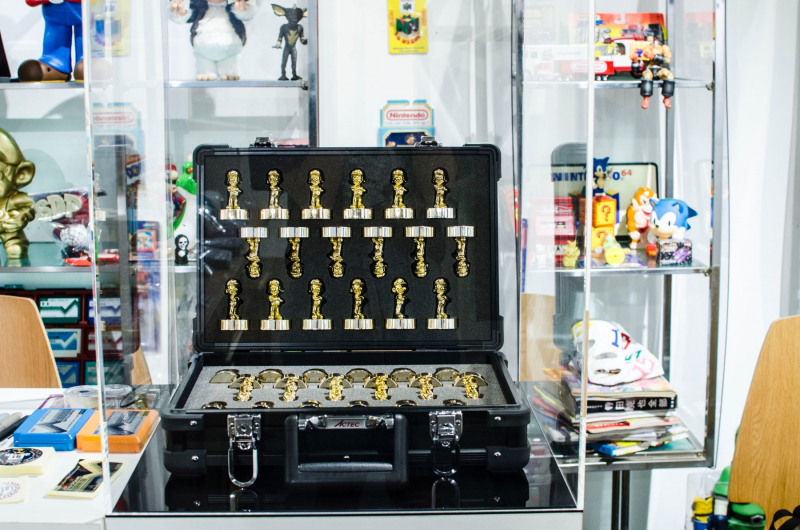
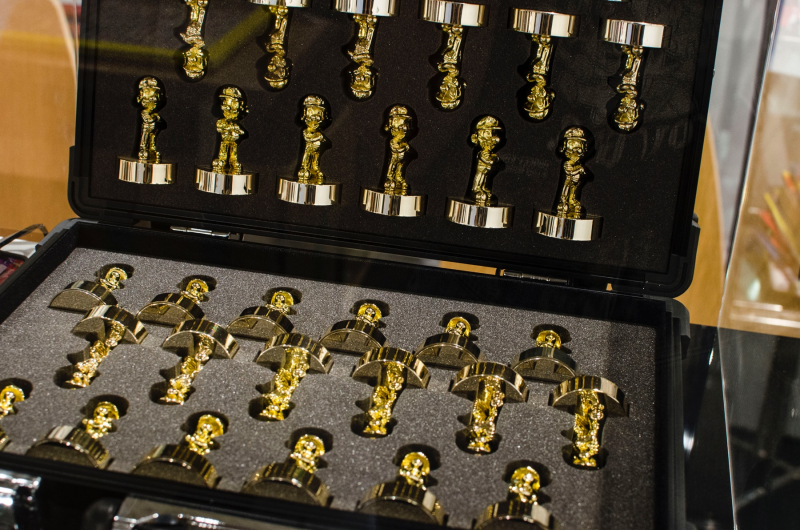
Enami: I’ve always liked small, heavy things; the gold Mario part was just a bonus.
江南:僕、小さくて重いものが好きなので、金のマリオはまさにドンピシャでして。
Julie: So you did a talk show with Bose from Scha Dara Parr. That must have been a blast.
Julie:スチャダラパーのBoseさんとのトークショウがあったのですね。盛り上がったでしょうね。
Enami: Bose also teaches at Seika University, and comes down to Kyoto every week. When I asked to be on his talk show he readily accepted. I was blown away by how good at public speaking he is.
江南:Boseさんも精華大学の先生をされていて、毎週京都に来られるんですよ。それで願いしたら、いいよ~と言ってくださって、トークショウを開催することになりました。話術がすごくて本当にビックリしました。
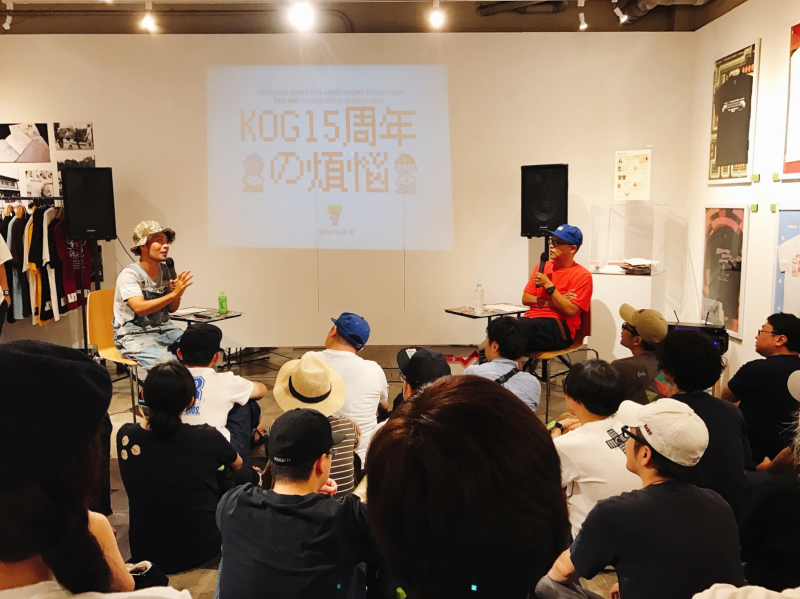
Julie: Both of you are connected to Kyoto, and also you both love Famicon, so I imagine it was a deep talk.
Julie:お二人とも京都つながり、そして、かなりのファミコン好きなので、ディープな内容になったでしょうね。
Enami: Yes, you could say it was deep. (laughs)
江南: はい。ディープでした(笑)
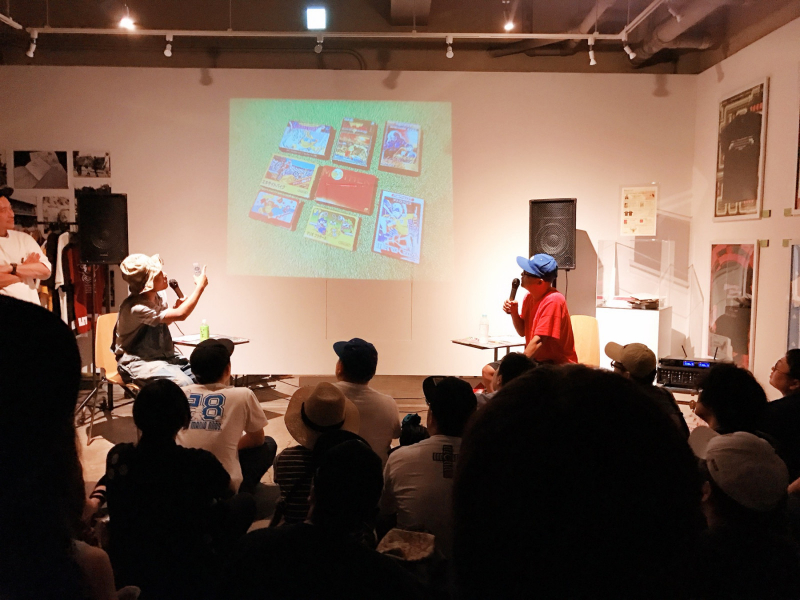
Julie: As Edit Mode welcomes its 15th anniversary, can you tell me about any prospects regarding future work?
Julie:15周年を迎えたエディットモードですが、今後の活動の展望などあれば教えてください。
Enami: We’re about to head into our 16th year, but since we’re all pretty laid back, we just do whatever we can each day, gradually expanding our activity. We plan to continue doing this now and in the future as well. Just collaborating with people we meet as we go along to make things and put on events. Something I’d like to pursue is designing clothes for a character and then making that into a t-shirt. Of course it would be a hidden setting. (laughs) I think as far as licensing goes, nobody has done that yet.
江南:16年目に向かっていっているところですが、僕たちはのんびりしているので、自分たちができる事を毎日こなして、少しずつでもやれることを広げていく。今までも、そしてこれからもそうやっていくつもりです。その中で出会った人と一緒に何かを作ったり、イベントをしたりしていこうと思います。
やりたい事といえば、ゲームのキャラクターが着ている服をデザインして、それを実際にTシャツ化したいと思っています。もちろんその設定は内緒で(笑)。
ライセンス商品としては、まだ誰もやっていないんじゃないかなと思って。
Julie: It would be cool if you could do some kind of reverse mixed media with t-shirts and games, similar to Megami Tensei like we were talking about before. I hope you can make it a reality. Thank you for all of the wonderful stories you’ve shared with me today!
Julie:冒頭の話題に出た女神転生のような、Tシャツとゲームの逆メディアミックスもカッコいいですね。ぜひ実現していただきたいです。本日はいいお話を聞かせていただき、ありがとうございました!
Enami: Thank you for the lengthy chat!!
江南:こちらこそ、長時間ありがとうございました!!
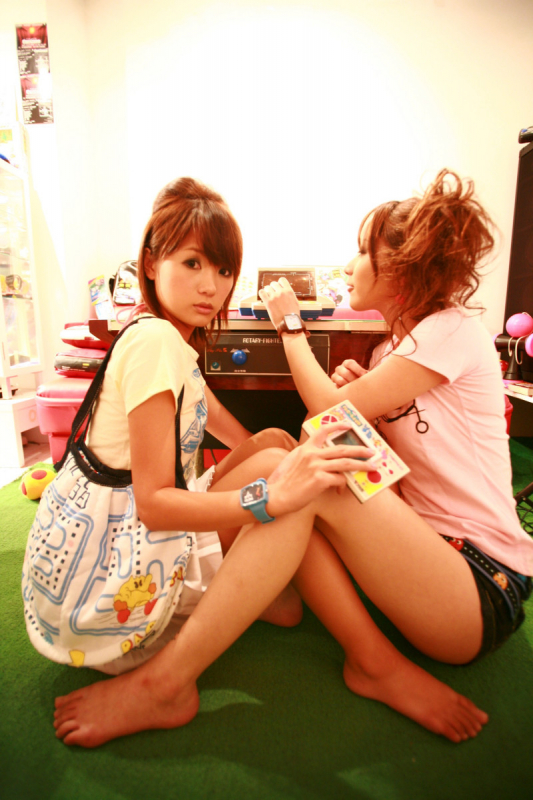
Photo:Julie Watai, Model:Kozue Haruna, Maki, Location:deltatune/撮影:Julie Watai、モデル:はるな梢、Maki、撮影協力:deltatune
After the Interview/対談を終えて
Since Enami and I are both from the same generation, from the very beginning we had a lot to dicuss about the Famicon, before talking about how it tied into the launch of THE KING OF GAMES. I got the impression by the way he passionally talked that he felt very moved by Nintendo.
江南さんとは同年代同士ということで、冒頭からファミコンの話に花が咲いた今回の対談でしたが、そこから繋がったTHE KING OF GAMES 立ち上げのお話し。まさに江南さんの熱意に任天堂が動かされたのだろうな、という印象を受けました。
Whenever I encounter an interesting subject (often a robot, machine, or something like that) when shooting, I have share how it moves me with other people involved when negotiating a shoot, and in that way, felt like there were certain points we could definitely relate to each other on.
私も撮影の際に魅力的な被写体(ロボットとか機材とかの場合が多いのですが)に出会えた時には、その感動を関係者に伝えてから撮影交渉を行うので、お話しの中で共感出来る部分もありました。
As a gamer for life, that love for the content itself makes you really value your relationship with that company. So because of that, I felt like other gamers can understand their commitment to their officially licensed releases, and that with their support THE KING OF GAMES has become what it is today.
あくまでゲームファンの一人として、そのコンテンツが好きだからこそ会社との関係性も大切にしていきたい。だから公式ライセンスでリリースをしている、というこだわりがゲームファンの間で理解され、支持されて今のTHE KING OF GAMES があるのだと感じました。
Maasaki Enami’s Profile
EDIT MODE Representative
After aqcuiring a license from Nintendo in 2002, THE KING OF GAMES, an apparel brand making use of early domestic Nintendo (NES) game motifs was launched, where he put in charge of planning, design, and production management.
He’s helped produce over 120 different t-shirts, and currently has more new projects in the works.
Major game titles that they’ve turned into t-shirts are Super Mario Bros., The Legend of Zelda, MOTHER, Kirby’s Dream Land), Fire Emblem, Pokémon, GAME & WATCH, and Splatoon, among others.
江南 匡晃さんプロフィール
株式会社エディットモード代表
2002年、任天堂株式会社よりライセンスを取得し、国内初の任天堂ゲームをモチーフにしたアパレルブランド「THE KING OF GAMES」を旗揚げし、同ブランドの企画、デザイン、生産管理を担当する。
120種類以上のTシャツを製作し、現在も新企画進行中。
Tシャツ化された主なゲームタイトルは、「スーパーマリオブラザーズ」「ゼルダの伝説」「マザー」「星のカービィ」「ファイアーエムブレム」「ポケットモンスター」「GAME&WATCH」「スプラトゥーン」など。
Related Links
EDITMODE Official site:https://editmode.jp/maintenance/
EDITMODE Official Twitter:https://twitter.com/editmode_kyoto
Translated by Jamie Koide
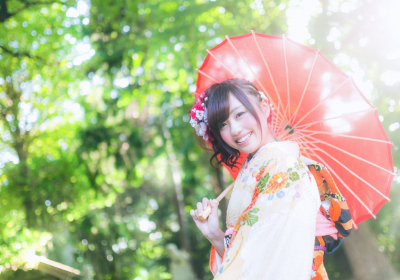
Kitakyushu Coming of Age Ceremony: Flamboyant Furisode and Hakama!
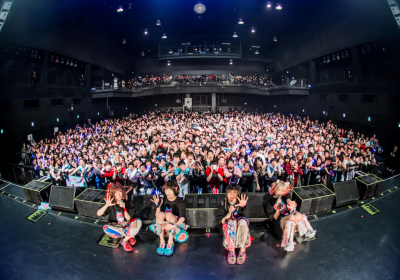
You’ll Melt More! Approach Enlightenment With “YOUTOPIA” Tour Finale at Zepp Tokyo!


